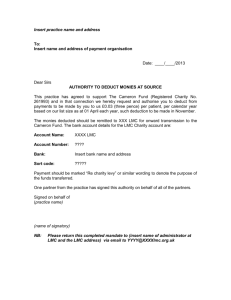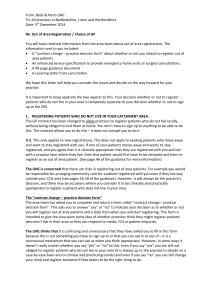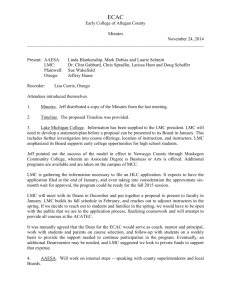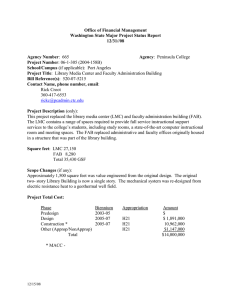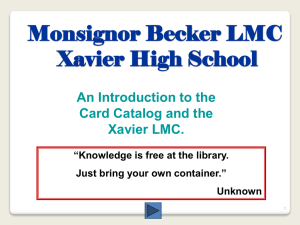Document 13135908
advertisement
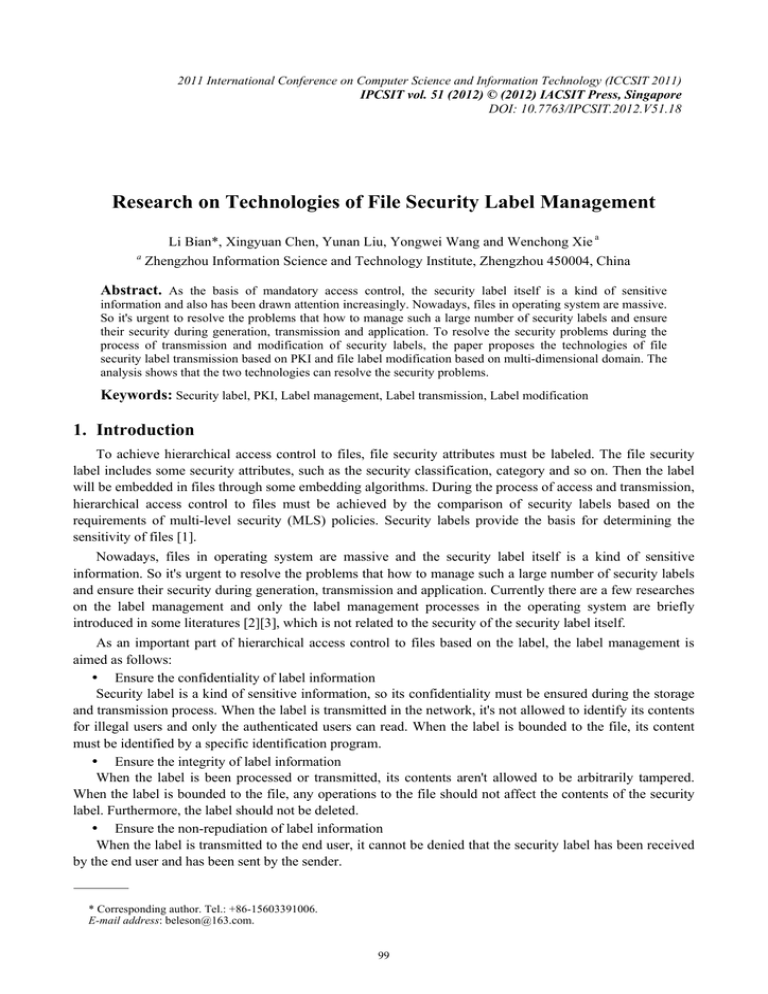
2011 International Conference on Computer Science and Information Technology (ICCSIT 2011)
IPCSIT vol. 51 (2012) © (2012) IACSIT Press, Singapore
DOI: 10.7763/IPCSIT.2012.V51.18
Research on Technologies of File Security Label Management
Li Bian*, Xingyuan Chen, Yunan Liu, Yongwei Wang and Wenchong Xie a
a
Zhengzhou Information Science and Technology Institute, Zhengzhou 450004, China
Abstract. As the basis of mandatory access control, the security label itself is a kind of sensitive
information and also has been drawn attention increasingly. Nowadays, files in operating system are massive.
So it's urgent to resolve the problems that how to manage such a large number of security labels and ensure
their security during generation, transmission and application. To resolve the security problems during the
process of transmission and modification of security labels, the paper proposes the technologies of file
security label transmission based on PKI and file label modification based on multi-dimensional domain. The
analysis shows that the two technologies can resolve the security problems.
Keywords: Security label, PKI, Label management, Label transmission, Label modification
1. Introduction
To achieve hierarchical access control to files, file security attributes must be labeled. The file security
label includes some security attributes, such as the security classification, category and so on. Then the label
will be embedded in files through some embedding algorithms. During the process of access and transmission,
hierarchical access control to files must be achieved by the comparison of security labels based on the
requirements of multi-level security (MLS) policies. Security labels provide the basis for determining the
sensitivity of files [1].
Nowadays, files in operating system are massive and the security label itself is a kind of sensitive
information. So it's urgent to resolve the problems that how to manage such a large number of security labels
and ensure their security during generation, transmission and application. Currently there are a few researches
on the label management and only the label management processes in the operating system are briefly
introduced in some literatures [2][3], which is not related to the security of the security label itself.
As an important part of hierarchical access control to files based on the label, the label management is
aimed as follows:
Ensure the confidentiality of label information
Security label is a kind of sensitive information, so its confidentiality must be ensured during the storage
and transmission process. When the label is transmitted in the network, it's not allowed to identify its contents
for illegal users and only the authenticated users can read. When the label is bounded to the file, its content
must be identified by a specific identification program.
Ensure the integrity of label information
When the label is been processed or transmitted, its contents aren't allowed to be arbitrarily tampered.
When the label is bounded to the file, any operations to the file should not affect the contents of the security
label. Furthermore, the label should not be deleted.
Ensure the non-repudiation of label information
When the label is transmitted to the end user, it cannot be denied that the security label has been received
by the end user and has been sent by the sender.
* Corresponding author. Tel.: +86-15603391006.
E-mail address: beleson@163.com.
99
Ensure the security of the system during any modifications to labels
If there are needs to modify the contents of the security label, it must not affect the security of the system.
Aimed at the problems of label transmission and modification, this paper studies the security rules that the
labels must be followed and the security of labels themselves during their transmission based on analyzing the
life cycle of the security label.
2. The Technology of File Security Label Transmission Based on PKI
A label management system consists of a LMC (Label Management Center) and an APC (Application
Processing Center). Its goal is to process user requests on security labels and ensure the security of labels in
their life cycle. When the EU (End User) applies for a label to the LMC, the APC verifies and processes the
request. If verification is success, the request will be sent to the LMC. Then LMC generates the security label
and transmits the label to the EU. Because of the openness and non-reliability of the network, the security
label during transmission is vulnerable to interception, tampering, forgery and other attacks. Network
congestion can also easily cause the loss of the security label. Therefore it's necessary to take measures to
ensure the security and reliability during security label distribution.
PKI is a security infrastructure to provide authentication, encryption, digital signature and other security
services for network users [4]. The purpose is to ensure the security of the network communication through
the technology of public key and authentication mechanism. The authentication, confidentiality, integrity and
non-repudiation of the network communication entity can be ensured by PKI.
2.1.
The Establishment of Secure Transmission Channel
Before the LMC transmits the security label to the EU, a secure transmission channel must be established
to ensure the security during transmission. The process of establishing the secure transmission channel is
shown in Fig. 1.
CA
③
③
②
②
① CertLMC
① CertEU
④ PKEU(RLMC)
LMC
④ PKLMC(REU)
EU
⑤ PKEU(REU)
⑤ PKLMC(RLMC)
Fig. 1. The process of establishing the secure transmission channel
① LMC sends its own identity certificate CertLMC to EU and EU also sends its own identity certificate
CertEU to LMC.
②After LMC and EU receive each other's identity certificate, CA verifies the legitimacy of the two sides'
certificates with its signature public key.
③ CA sends the verification results to LMC and EU. If the verification result is valid, then skip to ④.
Otherwise, require the other to update the certificate and the communication process should be suspended.
④ EU extracts the public key PKLMC from the LMC’s identity certificate. Meanwhile LMC extracts the
public key PKEU from the EU’s identity certificate. LMC generates a random number RLMC, which is
encrypted by PKEU, and sends the result PKEU(RLMC) to EU. Meanwhile, EU generates a random number REU,
which is encrypted by PKLMC, and sends the result PKLMC(REU) to LMC.
100
⑤ When PKEU(RLMC) has been received by EU, EU uses its own private key to decrypt it to get the
random number RLMC, then uses the LMC's public key PKLMC to encrypt RLMC, and sends the result
PKLMC(RLMC) to LMC. At the same time, when PKLMC(REU) has been received by LMC, LMC decrypts it to
get the random number REU with its own private key, then encrypts REU with the EU's public key PKEU and
sends the result PKEU(REU) to EU.
⑥ When PKEU(REU) has been received by EU, EU decrypts it to get the random number REU with its own
private key and compares it with its generated random number previously. At the same time, When
PKLMC(RLMC) has been received by LMC, LMC decrypts it to get the random number RLMC with its own
private key and compares it with its generated random number previously. If the comparison results are all the
same, the negotiation and exchange of the session key between the two sides is conducted. Right now, a
secure transmission channel between LMC and EU is established. Otherwise, it an error message is returned
and the communication process is suspended.
2.2.
The Secure Transmission of Security Labels
When the secure transmission channel has been established, LMC can transmit the security label to EU
through the channel. The confidentiality and integrity of security labels during transmission through network
can be ensured by security services provided by PKI. The process is shown as follows:
Generate the label header H. H mainly stores the security parameters that should be determined by
both the sender and receiver. These parameters mainly include the unique identification, active time and so on.
IDLMC||IDEU||TStart||TEnd
(1)
Generate a session key k for the secure communication using the Diffie-Hellman protocol [5].
Extract the serial number CIDEU and the public key PKEU from CertEU, and protect the session key k
with PKEU.
CIDEU||{k}PKEU
(2)
Encrypt the label header H and the label content M to generate {H}k and {M}k.
Link the contents above, hash the linked result and sign the hashed result using the LMC's private key
KLMC.
[Hash(IDLMC||IDEU||{H}k||CIDEU||{k}PKEU||{M}k)]KLMC
(3)
Link all the results above, form the label to be transmitted through network and send it to EU.
IDLMC||IDEU||{H}k||CIDEU||{k}PKEU||{M}k||[Hash(IDLMC||IDEU||{H}k||CIDEU||{k}PKEU||{M}k)]KLMC
It can be simply expressed as:
IDLMC||IDEU||Crypt0||Crypt1||Crypt2||Crypt3
(4)
Crypt0 indicates the encryption result of the label header {H}k. Crypt1 indicates the protected session key
CIDEU||{k}PKEU. Crypt2 indicates the encryption result of label contents {M}k, Crypt3 indicates the signature
result in the step (5).
2.3.
Identification of Security Labels on EU
When EU has received the security label sent from LMC, he must identify it and extracts its contents.
Assume that EU has received the message as follows:
IDLMC'||IDEU'||Crypt0||Crypt1||Crypt2||Crypt3
(5)
The process of identifying the message is as follows:
EU verifies that whether IDLMC' is equal to IDLMC and IDEU' is equal to IDEU. If it is not true, an error
message is returned to LMC.
EU hashes IDLMC'||IDEU'||Crypt0||Crypt1||Crypt2 with the same hash function and decrypts Crypt3 with
LMC's public key to PKLMC. Compare the hashed result and the decrypted result of Crypt3. If they are not
equal, then the label has been tampered and EU returns an error message to LMC.
EU reads the corresponding CIDEU in Crypt1, and gets the session key k with its own private key KEU.
EU decrypts Crypt0 with k to get the label header. Verify the validity of TStart' and TEnd'. That is,
determine whether TStart' is earlier than the current time. If not, the received label is not correct; Then
determine whether TEnd' is later than the current time. If not, the received label has expired.
101
2.4.
EU decrypts Crypt2 with k to get the plain-text content of the security label.
Security Analysis
2.4.1. Confidentiality
The session key k is generated according to the Diffie-Hellman protocol. During the generation of the
session key, it can resist the man-in-the-middle attacks as both sides have confirmed the identity of each other
before communication, LMC encrypts the contents of the security label with k and protects k with the EU's
public key PKEU. It effectively prevents the security label from the risk of illegal stealing during the
transmission from LMC to EU.
2.4.2. Integrity
LMC hashes the head and the content of the label. EU verifies the hashed value to determine whether the
label has been tampered during transmission. So the integrity of the label can be ensured effectively.
2.4.3. Non-repudiation
Since both sides have determined the identity of each other before communication, and the LMC's
identification, digital signature and other information are carried during the transmission of security label, EU
can verify the signature to determine the sender.
3. The File Label Modification Technology Based on Multi-dimensional Domain
3.1.
The File Label Structure Based on Multi-dimensional Domain
In today's increasingly complex application environments, the traditional one-dimensional security
classification label, such as BLP [6], has been unable to meet the security needs and also increases the
difficulty of tracking classified files. So the simple one-dimensional security classification label must be
extended to the multi-dimensional label, and the traditional static label must be extended to the one which
contains both static and dynamic attributes.
Referring to [7][8], according to the basic attributes and security attributes of the file, the contents of the
file label can be divided to the static characteristic label and the dynamic security label. The label structure is
shown in Fig. 2.
bit 0
1
4
7
8
12
24
32
LID
FID
FType
Crypto
FState
ClsLv
MulDom
DomSt
Space Domain
bit 8
Time Domain
16
Subject Domain
24
32
Fig. 2. The file label structure with multi-dimensional domain
The static characteristic label includes the unique label identification, the unique file identification and the
file type. The meaning of each part is as follows:
• The unique label identification LID (32bit): It is automatically assigned by LMC when the label is
generated and each label has a unique LID.
• The unique file identification FID (32bit): It is automatically generated by the system when the file is
created. Each FID is corresponding to one file.
• The type of the file FType (32bit): Each file has one specific file type.
The dynamic security label includes the encryption label, the file state, the classification level, the domain
switch label and the multi-dimensional domain. The meaning of each part is as follows:
The encryption label Crypto (1bit): It indicates that whether the file has been encrypted.
102
The file state FState (3bit): It indicates the inherent availability state of the file and is specified by the
security administrator. There are three states: ALLOW, DENY and AC (i.e. according to Access Control
policies).
The classification Level ClsLv (3bit): It indicates the degree of the confidentiality of the file. It can be
classified as follows from high to low: Top Secret, Secret, Confidential and Public.
The domain switch label DomSwt (1bit): It indicates whether the multi-dimensional domain is enabled.
When the value is 0, it's unable, which means that the environmental factors of files need not to be considered
when judging the request. Otherwise, it's enabled, which means that the environmental factors should be
considered first according to the rules when judging the request.
The multi-dimensional domain MulDom (24bit): It indicates the current application environment of
files, which can be further divided into the space domain, the time domain and the subject domain. Each
domain can be dynamically configured by security administrators. The meaning of each domain is as follows:
① Space Domain (8bit): It means that the space in which the file can be accessed. In the narrow sense, the
concept of space can be expressed as folders or a disk. In the broad sense, it can be expressed as a department,
or an organization.
② Time Domain (8bit): It indicates the time period which the file can be accessed. For example, some
files can only be accessed at work by setting this domain.
③ Subject Domain (8bit): It indicates the subjects which the file can be accessed. For example, there is a
confidential file and the drafter doesn't want all secret users can access it. The access control can be achieved
by setting this domain.
The static characteristic label describes the inherent attributes of the file, which is not allowed to change
during the life cycle of the file. The dynamic security label, which can be modified dynamically according to
the change of file application environments, describes the file security attributes in detail. With this
combination of the static and dynamic label structure, the security attributes and access conditions in the life
cycle of the file in a particular environment can be clearly described, which ensures the security and also
strong flexibility.
3.2.
The Rule of File Label Modification
Because the security label is not constant in its life cycle, it's necessary to modify the contents of the file
label according to the application environment on the premise of security principles. When the file label needs
to be modified, EU sends a modification request to LMC. When the request has been sent to LMC through the
secure transmission channel, the contents which need to be modified will be matched by rules in APC. After a
successful match, the request will be sent to LMC to implement label modification operation.
3.2.1.
The state variables
Definition 1 Subject set: S; File set: O; Access mode set A : {r , a, w, e} .
Definition 2 Security label set: L, includes subject label LS and file label LO. Classification level label set:
LC.
Domain switch set: DS, includes subject domain switch set DSS and file domain switch set DSO.
Space domain set: K, includes subject space domain set KS and file space domain set KO.
Subject domain set: P, includes subject subject domain set PS and file subject domain set PO.
Time sequence: T:={1,…,ti,ti+1,…}. Time period: TR T T , (ti , t j ) TR ti t j .
Definition 3 Access Matrix: M, Mij indicates that the subject Si can access the file Oj under the constraint
of multi-dimensional domain.
Security functions set: F, f F , f ( f S , f O , f C ) ,fS indicates the maximum clearance level function of the
subject, fC indicates the current clearance level function of the subject, and fO indicates the classification level
function of the file.
The current access set: b:= (S O A). It indicates what access mode which the subject S can access the
file O in the certain state.
103
Definition 4 The state set: V:= (b M F H K T P).
Definition 5 The request set: R:=S O LC, which indicates the subject S requests to modify the security
label LC of the file O.
LOD LO KO TR PO : The label LO can be used by the subject PO during the time period
TR and in the space KO. LSD LS K S T PS : The label LS can be used by the subject PS at the time T and
in the space KS.
Definition 6
3.2.2.
The functions of the domain operation
Definition 7 Get the start time of the time period start:TR T, start((ti, tj))= ti. Get the end time of the
time period end:TR T, end((ti, tj))= tj.
Definition 8 Get the space domain of the subject label L_getsub_k:LS KS. Get the time domain of the
subject label L_getsub_t:LS T. Get the subject domain of the subject label L_getsub_p:LS PS. Get
the space domain of the file label L_getobj_k : LO KO. Get the time domain of the file label
L_getobj_t:LO TR. Get the subject domain of the file label L_getobj_p:LO PO.
Definition 9 Judge whether the space domain of the subject is included in that of the file L_in_range_k:
KS KO {true, false}. Judge whether the time domain of the subject is included in that of the file
L_in_range_tr: T TR {true, false}.Judge whether the subject domain of the subject is included in that
of the file L_in_range_p: PS PO {true, false}.
Definition 10 Get the space domain in which the access mode x can be activated A_getobj_k:A KO.
Get the time domain in which the access mode x can be activated A_getobj_tr:A TR. Get the subject
domain in which the access mode x can be activated A_getobj_p:A PO.
Definition 11 Judge whether the space domain of the subject is included in that of the file when the subject
requests to access the file with the access mode x A_in_range_k: KS KO {true, false}. Judge whether
the time domain of the subject is included in that of the file when the subject requests to access the file
with the access mode x A_in_range_tr: T TR {true, false}. Judge whether the subject domain of the
subject is included in that of the file when the subject requests to access the file with the access mode x
A_in_range_p: PS PO {true, false}.
Definition 12 Get the domain switch value of the subject label: getsub_DS: LS DSS. Get the domain
switch value of the file label: getobj_DS: LO DSO.
3.2.3. The rule of file label modification
In the state v=(b,M,f,H,k,t,p), when the subject Si requests to modify the label of the file Oj to Lu, LMC
handles this request rq( Si , O j , Lu ) R following below steps:
(i) If getsub _ DS ( f s (S )) & &getobj _ DS ( fo (O)) 1 :
① If the conditions below satisfy, skip to (iii);
L _ in _ range _ k ( L _ getsub _ k ( f s ( Si )), L _ getobj _ k ( f o (O j ))) true
L _ in _ range _ tr ( L _ getsub _ t ( f s ( Si )), L _ getobj _ tr ( f o (O j ))) true
L _ in _ range _ p( L _ getsub _ p( f ( S )), L _ getobj _ p ( f (O ))) true
s
i
o
j
A
_
in
_
range
_
k
(
L
_
getsub
_
k
(
f
(
S
)),
A
_
get
_
k
(
x
))
true
s
i
A _ in _ range _ tr ( L _ getsub _ t ( f ( S )), A _ get _ tr ( x )) true
s
i
A _ in _ range _ p( L _ getsub _ p( f s ( Si )), A _ get _ p ( x)) true
② Otherwise,reject rq(Si,Oj,Lu).
(ii) If getsub _ DS ( f s (S )) & &getobj _ DS ( fo (O)) 0 , skip to (iii);
(iii) Judge according the following steps:
① If the conditions below satisfy, authorize rq(Si,Oj,Lu):
• fc(Si) Lu fo(Oj);
•
( Sk , O j , a) b Lu f c ( Sk )
Sk S , ( Sk , O j , w) b Lu f c ( S k )
( Sk , O j , r ) b f c ( Sk ) Lu
• Sk S , ( Sk , O j , r ) ( Sk , O j , w) b f c ( S k ) Lu ;
• Ow H (O j ), O j H (OP ( j ) ) Lu fo (OP ( j ) ) fo (Ow ) Lu ;
• The subject Si has the authority to modify the label of the file Oj.
The next state changes in these aspects:
• f * ( f {(O j , Lu )}) \{(O j , fo (O j ))} ;
104
• The other state variables don’t change, and the system runs into the state v*=(b,M,f *,H,k,t,p).
② Otherwise,reject rq(Si,Oj,Lu).
3.3.
Proof of the Rule
Theorem: If the state v=(b,M,f,H,k,t,p) is secure according to the axioms of ss-property, *-property and
ds-property [5], the state v* is also secure according to those axioms.
Proof: (1) Prove that v* is secure according to ss-property.
According to the result of the judgment, we can conclude that v*=v or v*=(b,M,f*,H,k,t,p). When v*=v, v* is
secure according to ss-property obviously, as v is secure according to ss-property. When v*=(b,M,f*,H,k,t,p),
the following two condition are divided:
(i) getsub _ DS ( f s (S )) & &getobj _ DS ( fo (O)) 1
As the rule, in the state v*, the multi-dimensional domains are not changed, so it doesn’t affect the security
of the system. As in:
fs*(Si)=fs(Si), fc*(Si)=fc(Si), fc(Si) Lu
(6)
We can also conclude from ss-property that:
fs(Si) fc(Si)
(7)
So we can conclude from (1) and (2) that:
fs*(Si) fc*(Si) Lu
*
(8)
*
So v =(b,M,f ,H,k,t,p) is secure according to ss-property.
(ii) getsub _ DS ( f s (S )) & & getobj _ DS ( fo (O)) 0
In this condition, the multi-dimensional domains are not judged. So according to the steps in (i),
v =(b,M,f*,H,k,t,p) is secure according to ss-property.
*
Combining (i) and (ii), we can conclude that v* is secure according to ss-property.
(2) Prove that v* is secure according to *-property.
When v*=v, v* is secure according to *-property obviously, as v is secure according to *-property. When
v*=(b,M,f*,H,k,t,p), the following two condition are divided:
(i) getsub _ DS ( f s (S )) & &getobj _ DS ( fo (O)) 1
As the rule, in the state v*, the multi-dimensional domains are not changed, so it doesn’t affect the security
of the system. From the rule, if the request is authorized, the subject label and the modified label of the file are
also confirm to the *-property. So v*=(b,M,f*,H,k,t,p) is secure according to *-property.
(ii) getsub _ DS ( f s (S )) & & getobj _ DS ( fo (O)) 0
In this condition, the multi-dimensional domains are not judged. So according to the steps in (i),
v =(b,M,f*,H,k,t,p) is secure according to *-property.
*
Combining (i) and (ii), we can conclude that v* is secure according to *-property.
(3) Prove that v* is secure according to ds-property.
When v*=v, v* is secure according to ds-property obviously, as v is secure according to ds-property. When
v*=(b,M,f*,H,k,t,p), the following two condition are divided:
(i) getsub _ DS ( f s (S )) & &getobj _ DS ( fo (O)) 1
As the rule, in the state v*, the multi-dimensional domains are not changed, so it doesn’t affect the security
of the system. From the result of the rule, b and M are not modified. So v*=(b,M,f*,H,k,t,p) is secure according
to ds-property.
(ii) getsub _ DS ( f s (S )) & & getobj _ DS ( fo (O)) 0
In this condition, the multi-dimensional domains are not judged. So according to the steps in (i),
v*=(b,M,f*,H,k,t,p) is secure according to ds-property.
Combining (i) and (ii), we can conclude that v* is secure according to ds-property.
So far, the theorem has been proved correct.
105
4. Conclusion
To resolve the security problems during the process of transmission and modification of security labels,
the paper proposes the technologies of file security label transmission based on PKI and file label modification
based on multi-dimensional domain. The security of file labels in the operating system can be increasingly
enhanced by introducing these two technologies. The files can also be prevented from being leaked which is
caused by the security of file labels themselves. The analysis shows that the two technologies can resolve the
security problems. But this paper doesn’t consider the integrity aspect of files and operations to files by
trusted subject. They need further investigation.
5. Acknowledgments
This work has been supported by the National High Technology Research and Development 863 Program
of China under Grant No. 2009AA01Z438.
6. References
[1] Chuchang Liu, Angela Billard, Maris Ozols, Nikifor Jeremic. Access Control Models and Security Labelling[C]. In:
30th Australasian Computer Science Conference, Ballarat, Australia, 2007.
[2] R Watson, B Feldman, A Migus, C Vance. Design and Implementation of the TrustedBSD MAC Framework. In
Proceedings 3rd DARPA Information Survivability Conference and Exposition, Washington DC, USA, Apr. 2003.
[3] C Vance, R Watson. Security Enhanced BSD. Net-work Associates Laboratories, Jul. 2003, pp. 17-22.
[4] A Nash, W Duane, C Joseph, D Rink. PKI: Implementing and Managing E-Security. The McGraw-Hill Companies,
2001
[5] Diffie W, Hellman ME. New Directions in Cyptography. IEEE Transactions on Information Theory, 1976, IT22(6), pp. 644-654
[6] D.E Bell, L.J Lapadula. Secure computer systems: a mathematical model. Technical Report, ESD-TR-73-278.
MITRE Corporation, Bedford, MA, USA, 1973, pp. 12-29.
[7] L Tan, MT Zhou. Design and Implementation of BLP with Time Character on Linux. Computer Science, 2007,
34(5), pp.92-95.
[8] L Bian, XY Chen, YW Wang. An Improved Multi-dimensional File Label Model. In Proceedings 2nd International
Symposium on Computer Network and Multimedia Technology, Wuhan, China, Dec. 2010, pp. 283-286.
106
